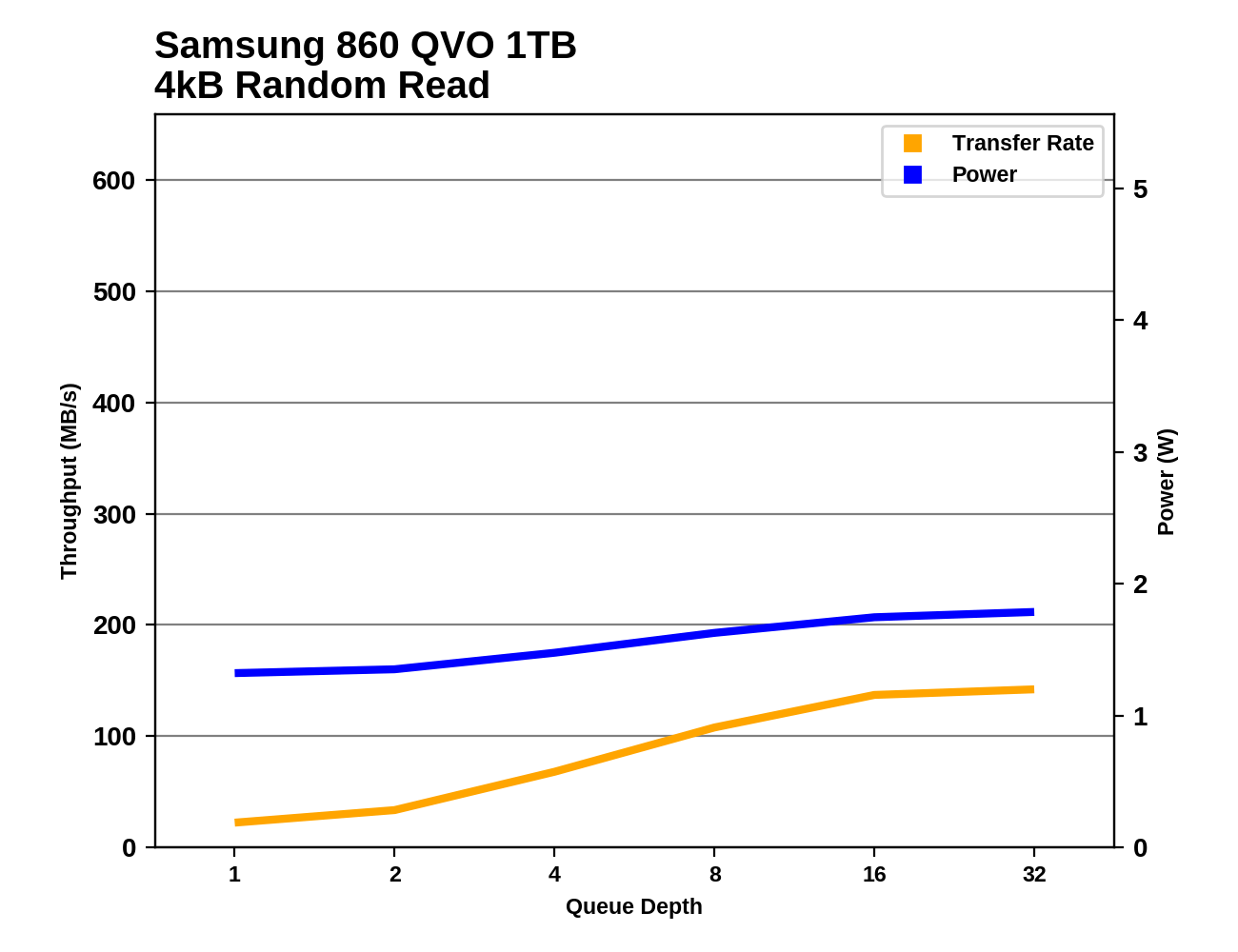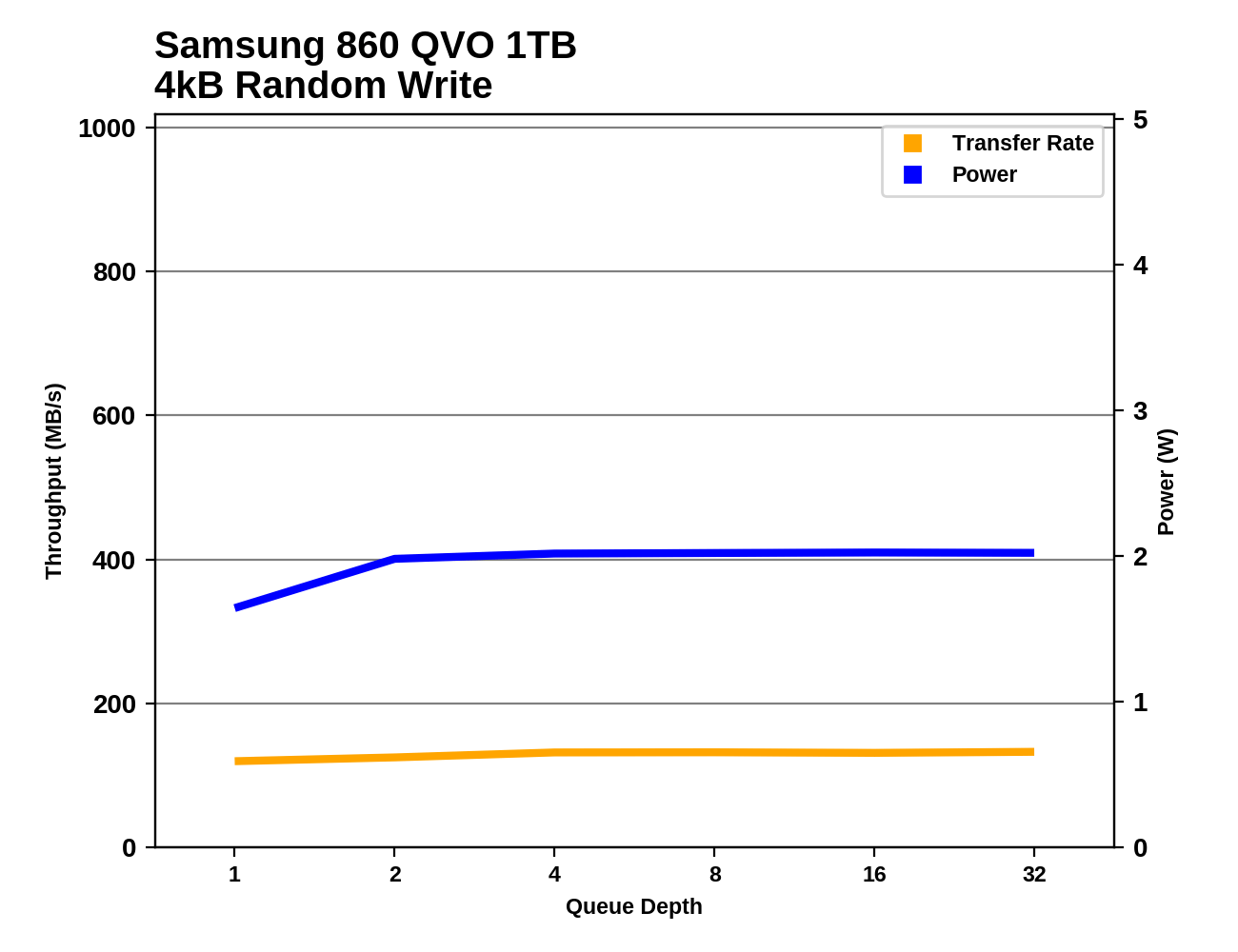The Samsung 860 QVO (1TB, 4TB) SSD Review: First Consumer SATA QLC
by Billy Tallis on November 27, 2018 11:20 AM ESTRandom Read Performance
Our first test of random read performance uses very short bursts of operations issued one at a time with no queuing. The drives are given enough idle time between bursts to yield an overall duty cycle of 20%, so thermal throttling is impossible. Each burst consists of a total of 32MB of 4kB random reads, from a 16GB span of the disk. The total data read is 1GB.

The burst random read performance of the Samsung 860 QVO is clearly lower than the 3D TLC competition, while the Intel/Micron QLC NVMe drives have no trouble competing against the field of mainstream SATA TLC drives. Even in the worst case of the smallest QVO being entirely full, read speeds are still vastly better than a hard drive.
Our sustained random read performance is similar to the random read test from our 2015 test suite: queue depths from 1 to 32 are tested, and the average performance and power efficiency across QD1, QD2 and QD4 are reported as the primary scores. Each queue depth is tested for one minute or 32GB of data transferred, whichever is shorter. After each queue depth is tested, the drive is given up to one minute to cool off so that the higher queue depths are unlikely to be affected by accumulated heat build-up. The individual read operations are again 4kB, and cover a 64GB span of the drive.

On the longer random read test, the Toshiba TR200 DRAMless TLC drive is no longer able to stay ahead of the 860 QVO, and even the Intel/Micron QLC drives fall behind most mainstream SATA drives (especially when full).
 |
|||||||||
| Power Efficiency in MB/s/W | Average Power in W | ||||||||
The power consumption of the 860 QVO during the random read test is only slightly higher than its TLC-based relatives, but that's plenty to push its efficiency scores into last place, given the poor performance.
 |
|||||||||
The queue depth scaling of the 860 QVO during random reads is fairly typical in shape, with improvements starting to taper off after QD16. However, the vertical scale is important: the QVO doesn't ever reach even half the performance of the best TLC-based SATA SSDs.
Looking at the 1TB 860 QVO's random read results compared to all the other SATA drives in the benchmark database, it is clear that the QVO isn't anywhere near the cutting edge for power efficiency or peak performance, but there are worse drives out there.
Random Write Performance
Our test of random write burst performance is structured similarly to the random read burst test, but each burst is only 4MB and the total test length is 128MB. The 4kB random write operations are distributed over a 16GB span of the drive, and the operations are issued one at a time with no queuing.

The SLC cache of the 860 QVO is very effective for the burst random write test, leaving it tied or slightly ahead of the 860 EVO.
As with the sustained random read test, our sustained 4kB random write test runs for up to one minute or 32GB per queue depth, covering a 64GB span of the drive and giving the drive up to 1 minute of idle time between queue depths to allow for write caches to be flushed and for the drive to cool down.

On the longer random write test, the larger SLC cache and greater parallelism of the 4TB 860 QVO helps it keep pace with other top SATA SSDs, but the 1TB QVO has to settle for being slightly faster than the DRAMless TLC drive.
 |
|||||||||
| Power Efficiency in MB/s/W | Average Power in W | ||||||||
The QVO is again a bit more power hungry than most of the TLC drives, which doesn't hurt the 4TB QVO's efficiency score much thanks to its good performance, but the 1TB QVO ends up tied for last place with the full-drive performance from the Intel/Micron QLC drives.
 |
|||||||||
The 1TB 860 QVO shows very little random write performance scaling with increasing queue depth, though power consumption does go up significantly from QD1 to QD2. The 4TB 860 QVO shows a much more typical scaling up to saturation at QD4, with a performance curve that is almost an exact match for the 4TB 860 EVO.
There are some TLC SATA SSDs that draw the same power to deliver half the random write performance of the 1TB 860 QVO, but in the grand scheme of things the 1TB QVO's results on this test are sub-par. The 4TB starts out in the same spot but ends up hitting the SATA performance wall without consuming too much power.












109 Comments
View All Comments
Lolimaster - Thursday, November 29, 2018 - link
HDD's sweet spot for manufacturers is the 4TB and up, they can't really make them cheaper than $40-50 no matter the size, it got tons of physical moving parts, a big chunk of well crafted aluminum, special sealing, etc vs an SSD that is just nand and a plastic casing before at least you got a thin aluminum case.Glaurung - Tuesday, November 27, 2018 - link
Spinning drives aren't going away - capacities are still going up and spinning drives are still the best deal for extremely high capacity storage - like NAS and datacentre storage. That's unlikely to change any time soon. But the amount of storage that you're realistically going to want inside your computer? It's now affordable to go all SSD for your local internal storage.But storage inside your laptop has until now been a case of needing two drives, a fast SSD to boot off of and a slow HDD for your data. Or else pay a ton for a high capacity SSD, or make do with a small drive
Dr. Swag - Tuesday, November 27, 2018 - link
Selling an inferior SSD to the 860 evo for more! What a great ideaPaoDeTech - Tuesday, November 27, 2018 - link
Lower cost (QLC) higher capacity SSDs are very welcome. Is as simple as that. I read an interesting study that basically concludes that an SSD lifespan is usually limited by age not total writes. Interesting. Can anybody confirm or deny?hojnikb - Tuesday, November 27, 2018 - link
Not really. SSDs don't tend to die of old age or exhausted endurance (not in client workloads anyway) but rather random controller faulires and firmwar bugs.One considuration with such flash is data retention. As these are fairly large drives, they will be used for storage and hence this can become an issue.
PaoDeTech - Tuesday, November 27, 2018 - link
Here's the article: https://www.zdnet.com/article/ssd-reliability-in-t...hojnikb - Wednesday, November 28, 2018 - link
Quickly skimming the article, it does seem to suggest, that age has an effect on raw bit errors. What it doesn't include (not that i can find) is wheter drives were the same model and manufacturer.Older drives could be of inferior controllers and weaker firmware design which can't cope with bit errors as well.
spkay31 - Tuesday, November 27, 2018 - link
Personally I think the Intel 660p NVMe SSD's offer a very nice price performance tradeoff when on sale. Yesterday an Intel 660p 1TB drive was on sale for $130. At around 1800Mbps it's ~ 3.5X faster than a SATA ssd and about 45% cheaper than a Samsung 970 EVO 1TB NVMe drive. OK, so it's 1800Mbps vs 3200Mbps but again for my uses that is certainly excellent speed improvement from a SATA ssd and I'm willing to accept some of the other shortcomings of QLC. My experience is that QLC is already a very reasonable value proposition for many applications.JoeyJoJo123 - Tuesday, November 27, 2018 - link
While I have nothing against the Intel 660p, not QLC, and I very much welcome these technologies, even considering black friday """deals""", I still don't think it has become price competitive (yet).I purchased an 860 EVO 1TB for $127 ($127 after tax/shipping), and then later an MX500 2TB for $209 ($229 after tax/shipping). (Bought the 860 EVO 1TB since the 2TB was $299 and therefore much more expensive in $/GB, and because I hadn't seen anything better by the time it was Saturday, but CyberMonday on Amazon brought the $209 MX500. I may or may not return the 860 EVO.)
Both of these drives are 3D TLC based, and still have their marginal sustained read/write advantages over 3D QLC. Given the (roughly) equivalent price between a 1TB 860 EVO 1TB and Intel 660p 1TB, I don't think it's unfair to say that the 860 EVO should be every customer's pick every single time (again, given these """deal""" prices).
As always, it'll take some time before newer technologies drop in prices and mature in overall value. I'm sure it'll happen for QLC drives, as they did with MLC and TLC before them, but it just hasn't happened quite yet.
Impulses - Thursday, November 29, 2018 - link
Wait what? The 2TB MX500 hit $209 this year? Was it a flash sale or something? I had price alerts set on it, the 860 EVO, and the WD Blue/SanDisk Ultra and the cheapest I saw for a 2TB was $255... Granted I was mostly looking at Amazon, where'd you score that deal?